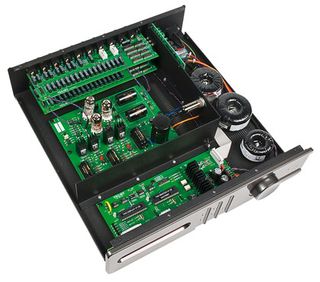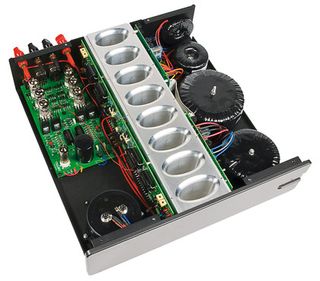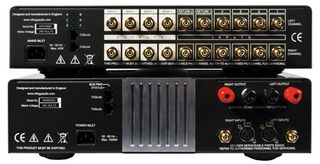TechRadar Verdict
Trilogy is reborn in a totally revitalised form offering a mountain of features in some stunning casework with a very distinctive finish. The key quality of musicality is still at the fore and that's what appeals above all else
Pros
- +
Exceptional musicality
- +
Huge flexibility
- +
Superb build quality
Cons
- -
Price high
- -
Those after precise imaging and inky-black backgrounds won't be impressed
Why you can trust TechRadar
Despite appearances, the latest Trilogy models are still valve amplifiers, but they have some distinct differences to most of the breed. The 990 power amplifier is a hybrid design with a solid-state output stage of the feedback-free variety and the 909 preamp is the most sophisticated example of its type in the glass-audio world, thanks to onboard microprocessing that makes an iPod look ill-equipped.
A clue as to its flexibility lies in the dot-matrix display. This can be set to show volume level, input and even the time, but before you can do anything with the 909 you need to enter a PIN code.
This is for security reasons, but you only need to do it once unless the preamp is unplugged from the mains for more than half an hour. It's unlikely to stop some 'tea leaf' from half-inching it should he feel the need, but is worth remembering if you ever spot one on eBay.
More relevant features include timer turn on/off, input naming (with alternative language options), maximum volume setting (to stop your kids destroying the speakers), variable input gain and selectable record out – which allows separate listen and record.
The list continues to include multiroom readiness and when the 909 is connected to a Trilogy power amplifier with the TASlink bus system, it can show information about the amp such as the operating temperature.

TRILOGY 909: The preamp's internals are dominated by the three transformers on the right-hand side
This has more features than you can shake a stick at to be frank and more, perhaps, than most of us are ever likely to need, but according to Poulsen they can be incorporated into the equipment without undermining sound quality and they clearly differentiate the 909 from its competitors.
Rather than a potentiometer, the 909 preamp uses shunt attenuation via Reed relays to control volume and has a shunt- regulated power supply with Mundorf film-foil capacitors.

TRILOGY 990: The heatsink shields the amplification from the power supply
The 990 power amplifier is built around a massive central heatsink. This element has to be milled from a solid aluminium billet and, therefore, adds not a little to the cost of the 'amplifier'. It does look stunning, though.
Turn the amp on and blue LEDs illuminate each hole. Under the lid you will find a choke input and shunt-regulated valve stage driving a fully bridged transistor output stage, one which itself is split into FETs for the first watt and bi-polar devices where extra current is required, so it is almost a tri-brid in practice.
Sound quality
The Trilogy pairing matches the superb paint finish of the casework with a high-quality dynamic and beautifully timed sound that reveals a lot of detail, whilst keeping the spotlight on the music at all times. This is a distinctly valve characteristic: the ability to bring out the message in the music ahead of more tangible and matter-of-fact aspects like tone, power and imaging.
The Trilogy components do this without the usual limitation on power that pure glass designs struggle with and which restrict the level at which you can play and the speakers that can be used. Here we have the grace and the grunt, albeit without the grip one gets with pure solid state power amps.
With the resident Bowers and Wilkins 802D speaker there is a shortfall in terms of bass solidity compared to our admittedly bigger – in terms of power if not money – Classé CA-2200 power amp. What you get instead is a fluidity and nimbleness across the band that makes the music significantly more engaging and well, musical.
Its balance stops you listening to the sound and focus on the music. Avishai Cohen's double bass-playing doesn't have the power that one expects, but it has a pace and dexterity that is far more engaging. This quality extends to everything you play, be it Keith Jarrett's remarkable poise on the keyboard or the improvisations of Brewed By Noon's jazz-rock.
We pulled out a pair of Living Voice Auditorium OBX-R speakers to see if they might gel a bit better and provide the self-damped bass that Trilogy considers suited to its products. This proves to be the case, the bass while not hugely extended is tight and well-defined with bass lines as articulate as you like.
The emphasis is still on the tune however: these amplifiers don't seek to impress with sound effects, rather they concentrate on the details that matter. These include the timbre of instruments and voices and the ability to keep up with the pace of the playing. It's almost as if other amps struggle to achieve this, the degree of freedom from overhang being a real eye-opener.

We also tried PMC's mighty PB1i speaker to see if the amps could control its ATL bass system, which it can; the bass remains taut and dynamic with good extension and plenty of timbral detail. What also comes through is the high level of detail that the amp can deliver, which is useful on good recordings, but can be a bit too revealing of lesser ones.
There is a degree of midrange emphasis that can exaggerate artefacts that other amplifiers leave relatively disguised. The PB1i is particularly revealing through the midband and for this reason may not be the best choice for these amps despite its lovely bass.
One problem with the 909 is its fairly high noise, which turned out to be down to the tubes doing the amplification. Swapping them for a quieter set lowered the noise considerably. Not completely, but to a level that's about average for glass audio which is rarely, if ever silent. Nic says he will be reducing gain in the pre and power to bring it down further still.
The 909/990 pairing is a welcome return for a company that puts rather more thought into the internals and execution of its products than most in valve audio. Speakers need to be carefully selected for best results, but you won't find this much speed and fluidity combined with adequate power in many other quarters.
Follow TechRadar Reviews on Twitter: http://twitter.com/techradarreview

Is there a moral imperative for businesses to share data?

Why sovereign AI infrastructure is driving worldwide adoption of Generative AI

Real life 6G speed tests revealed by Japanese tech giants — 100Gb/s transmissions could become the norm for mainstream wireless network data transfer within a few years
